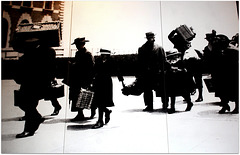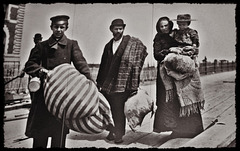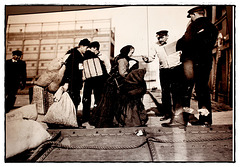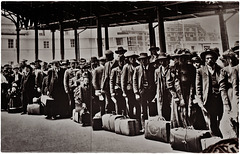Dinesh's photos
Lost in thought
| |
|
| |
|
"I've been a dweller on the plains,
have sighed when summer days were gone;
No more I'll sigh; for winter here
Hath gladsome gardens of his own."
~ Dorothy Wordsworth
An Epitaph
| |
|
Humble, born to the earth,
They knew where they stood.
When they moved,
It was because they must.
Anger moved them,
And the desire to be elsewhere,
Or something in them
Responding to music.
They knew also
What waiting can be.
Side by side, they mastered it,
Like an old married couple.
"Epitaph for a Pair of Old Shoes" ~ Donald Justice
A Barn
| |
|
White
| |
|
|
|
When they tired of painting sun and wind, they turned to fog,
ice, and snow, tried to find some other way to catch the light,
to pin it down, a brooch on a dress or a nail in a barn.
How many different tubes of paint are there for white?
.....................................
.....................................
Soon, another cold front will move in from the west,
turning the air crystalline, and they will go at it again:
a flurry of brushstrokes, a snow squall
of new paintings shivering on their easels.
Excerpt "Impressionists in Winter" ~ Barbara Crooker
HFF ye all, and a great weekend
Snow
| |
|
Late December: my father and I
are going to New York, to the circus.
He holds me
on his shoulders in the bitter wind:
scraps of white paper
blow over the railroad ties.
My father liked
to stand like this, to hold me
so he couldn't see me.
I remember
staring straight ahead
into the world my father saw;
I was learning
to absorb its emptiness,
the heavy snow
not falling, whirling around us.
"Snow" ~ Louise Gluck
en.wikipedia.org/wiki/Louise_Gl%C3%BCck
Winter morning
| |
|
On a summer afternoon
| |
|
| |
|
|
Adam Smith entered the realm of economics by asking himself about the implications of human greed, and how self-interest could work for the common good. The 900 pages of ‘The Wealth of Nations (1776) was essentially an extended essay in pursuit of that quest. It shattered the protectionist philosophy of mercantilism, which had reigned supreme in economic thought for 200 years. Smith’s speculations led him to postulate the existence of ‘society’, in whose mechanism all people participate, and to formulate the laws of ‘the market’. He outlined the workings of production, of competition, of supply and demand, and of prices. He paid special attention to the organization of labour. This is shown in his famous description of a pin factory. Rationalized tasks and specialized skills enable the workforce to produce 48,000 pins a day, where each of the workers might individually produce only two or three. He also stressed the self-regulating nature of market, which, if unhindered, would foster social harmony. He identified two basic market laws – the law of Accumulation and the Law of Population. “The demand for men’, he wrote rather shockingly, ‘necessarily regulates the production of men.’ His watchword was: “let the Market Alone”.
The Science of Economics has been exploring the issues raised by Smith ever since. The trail leads from Richardo, Malthus, and Marx, via Hobson, Bastiat, and Marshall, to Veblen, Schumpeter, and Keynes. In Smith’s hands it was a branch of speculative philosophy, and its greatest practitioners have recognized the fragility of their conclusions. In popular mind, however, economics has greater pretensions. It has moved into the oid let by the decline of religion and the moral consensus; and it is increasingly seen as the main preoccupation of public policy, a panacea for social ills, the source even of private contentment. From being a technical subject, explaining human society in the way that medicine explains the human body, it threatens to become an end in itself, laying down goals, motives, incentives. Smith, the moralist, would have been appalled. ~ Excerpt: page 604 (Europe – A History)
Vegetables
| |
|
Summer hobby
| |
|
| |
|
Family Portrait
| |
|
Immigrants / Luggage
| |
|
www2.scholastic.com/browse/subarticle.jsp?id=1673
New Social Groupings: Immigrants, Urbanites, and Union Members. In 1890 the American people numbered 63 million, double the 1860 population. During these years the nation's cities underwent tremendous growth. Many new urbanites came from the American countryside, but many others came from abroad. From 1860 to 1890 more than 10 million immigrants arrived in the United States; from 1890 to 1920, 15 million more arrived. Most were concentrated in northern cities: by 1910, 75 percent of immigrants lived in urban areas, while less than 50 percent of native-born Americans did so. In the 1880s the so-called new immigration began: in addition to the Germans, Scandinavians, Irish, and others of the older immigrant groups, there came such peoples as Italians, Poles, Hungarians, Bohemians, Greeks, and Jews (from central and eastern Europe, especially Russia). Roman Catholics grew in number from 1.6 million in 1850 to 12 million in 1900, producing a renewed outburst of bitter anti-Catholic nativism in the 1880s. The large cities, with their saloons, theaters, dance halls, and immigrant slums, were feared by many native American Protestants, who lived primarily in small cities and the rural countryside.
Immigrants
| |
|
www2.scholastic.com/browse/subarticle.jsp?id=1673
New Social Groupings: Immigrants, Urbanites, and Union Members. In 1890 the American people numbered 63 million, double the 1860 population. During these years the nation's cities underwent tremendous growth. Many new urbanites came from the American countryside, but many others came from abroad. From 1860 to 1890 more than 10 million immigrants arrived in the United States; from 1890 to 1920, 15 million more arrived. Most were concentrated in northern cities: by 1910, 75 percent of immigrants lived in urban areas, while less than 50 percent of native-born Americans did so. In the 1880s the so-called new immigration began: in addition to the Germans, Scandinavians, Irish, and others of the older immigrant groups, there came such peoples as Italians, Poles, Hungarians, Bohemians, Greeks, and Jews (from central and eastern Europe, especially Russia). Roman Catholics grew in number from 1.6 million in 1850 to 12 million in 1900, producing a renewed outburst of bitter anti-Catholic nativism in the 1880s. The large cities, with their saloons, theaters, dance halls, and immigrant slums, were feared by many native American Protestants, who lived primarily in small cities and the rural countryside.
Immigrants
| |
|
www2.scholastic.com/browse/subarticle.jsp?id=1673
New Social Groupings: Immigrants, Urbanites, and Union Members. In 1890 the American people numbered 63 million, double the 1860 population. During these years the nation's cities underwent tremendous growth. Many new urbanites came from the American countryside, but many others came from abroad. From 1860 to 1890 more than 10 million immigrants arrived in the United States; from 1890 to 1920, 15 million more arrived. Most were concentrated in northern cities: by 1910, 75 percent of immigrants lived in urban areas, while less than 50 percent of native-born Americans did so. In the 1880s the so-called new immigration began: in addition to the Germans, Scandinavians, Irish, and others of the older immigrant groups, there came such peoples as Italians, Poles, Hungarians, Bohemians, Greeks, and Jews (from central and eastern Europe, especially Russia). Roman Catholics grew in number from 1.6 million in 1850 to 12 million in 1900, producing a renewed outburst of bitter anti-Catholic nativism in the 1880s. The large cities, with their saloons, theaters, dance halls, and immigrant slums, were feared by many native American Protestants, who lived primarily in small cities and the rural countryside.
| |
|
www2.scholastic.com/browse/subarticle.jsp?id=1673
New Social Groupings: Immigrants, Urbanites, and Union Members. In 1890 the American people numbered 63 million, double the 1860 population. During these years the nation's cities underwent tremendous growth. Many new urbanites came from the American countryside, but many others came from abroad. From 1860 to 1890 more than 10 million immigrants arrived in the United States; from 1890 to 1920, 15 million more arrived. Most were concentrated in northern cities: by 1910, 75 percent of immigrants lived in urban areas, while less than 50 percent of native-born Americans did so. In the 1880s the so-called new immigration began: in addition to the Germans, Scandinavians, Irish, and others of the older immigrant groups, there came such peoples as Italians, Poles, Hungarians, Bohemians, Greeks, and Jews (from central and eastern Europe, especially Russia). Roman Catholics grew in number from 1.6 million in 1850 to 12 million in 1900, producing a renewed outburst of bitter anti-Catholic nativism in the 1880s. The large cities, with their saloons, theaters, dance halls, and immigrant slums, were feared by many native American Protestants, who lived primarily in small cities and the rural countryside.
| |
|
|
|
www2.scholastic.com/browse/subarticle.jsp?id=1673
The era known as the Gilded Age (1870s to 1890s) was a time of vigorous, exploitative individualism. Despite widespread suffering by industrial workers, southern sharecroppers, displaced American Indians, and other groups, a mood of optimism possessed the United States. The theories of the English biologist Charles Darwin-expounded in On the Origin of Species (1859)- concerning the natural selection of organisms best suited to survive in their environment began to influence American opinion. Some intellectuals in the United States applied the idea of the survival of the fittest to human societies ( Social Darwinism) and arrived at the belief that government aid to the unfortunate was wrong.


















